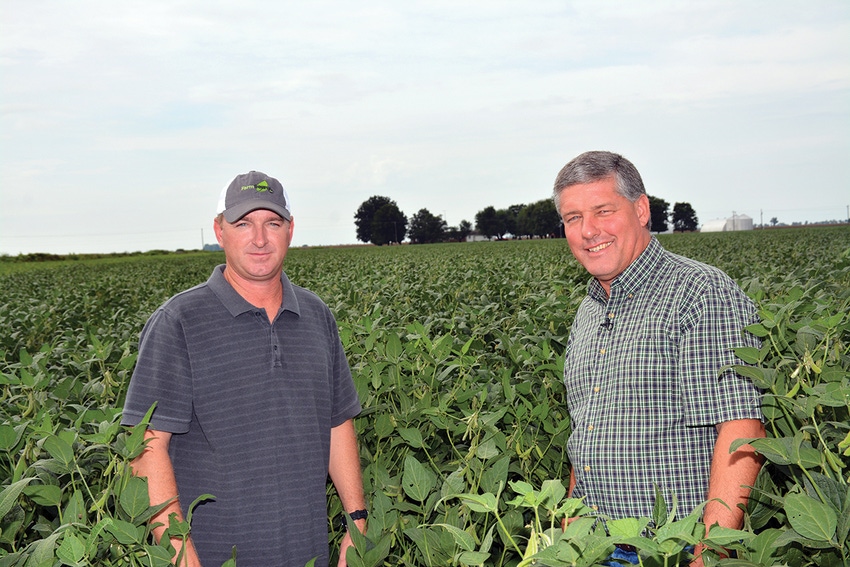September 10, 2016

Brad Gilmer and Lance Lawson understand what all the fuss is about regarding the hundreds of acres of crops that have been damaged by the off-label use of dicamba herbicide on dicamba-tolerant crops this summer.
But they also believe farmers can apply the new dicamba formulation Monsanto is expecting EPA to register in time for the 2017 crop season without most of the injury complaints that accompanied the illegal use of the older formulations in 2016.
Gilmer and Lawson, partners in L&G Farms near Matthews, Mo., were among 33 farmers in five states who participated in the Monsanto Ground Breakers Field Trials Under Permit Program this summer. Participants were allowed to plant one trial plot of Asgrow Roundup Ready 2 Xtend soybeans and use an over-the-top application of dicamba herbicide.
“Monsanto selected this field because it is isolated from other, sensitive crops,” said Gilmer, who lives in Matthews, Mo. “But we never saw any evidence of drift to the surrounding fields from the application of the new dicamba formulation.”
“They were out here monitoring the air and checking sensors for evidence of dicamba moving off the field,” said Lawson, who lives in nearby Sikeston, Mo. “We never saw any indications of a problem.”
Rained out half-way
Gilmer and Lawson started planting their 120-acre field of Asgrow Roundup Ready 2 Xtend soybeans on May 19 and got rained out about half-way across the field. They finished planting on May 22.
“It takes a while when you’re changing varieties every few rows,” said Lawson, who estimated 24 Roundup Ready 2 Xtend varieties were planted in the field, which extends about three-fourths of a mile across in this area of the Missouri Bootheel.
The partners normally apply their pre-emergence herbicide with the planter, but “they were changing seed so often we decided not to do that on this field,” said Lawson. “We added the pre-emergence herbicide when we applied the XtendiMax herbicide with a high-boy.”
Monsanto monitored the planting and spraying closely. “These fields were sprayed under strict supervision and monitored by Monsanto representatives,” according to a press release. “No other farmers in the United States were allowed to spray any kind of dicamba product over the top of Roundup Ready 2 Xtend soybeans in 2016.”
Lawson applied Valor on about half the field and Dual on the other half. They sprayed Warrant on a number of the other acres they farm. The partners believe residual herbicides will remain an important part of their weed control program in the Roundup Ready 2 Xtend system.
“You could do it without it if you really wanted to (not spray residual herbicides); you would have to stay on top of it,” said Lawson. “But it’s better if you have a residual herbicide in there.”
Give crops a good start
“It gives you more of a window that helps down the road,” said Gilmer. “Instead of everything just growing with the crop, we still feel like you’re going to have to apply a pre-emergence herbicide and use what most people would call the old-school technology.”
Lawson said he and Gilmer believe the new formulation worked well.

Lance Lawson and Brad Gilmer have been keeping a close eye on the Asgrow Roundup Ready 2 Xtend soybeans growing on their farm near Matthews, Mo.
“I wish they could get approval so that we could spray it,” he said. “I know people are upset because of some of the drift, but they were using generics, and they weren’t using the VaporGrip (the new technology that will be in the XtendiMax herbicide formulation).
“Our thinking is some people came in and put large amounts – 8 to 16 ounces – of the herbicide out,” said Gilmer. “Then you get more volatility and more product in the field.”
The field the partners were allowed to spray with XtendiMax has corn on two sides and dicamba-tolerant cotton that someone else is growing on one side and their own dicamba-tolerant cotton on the other.
“We think it worked really well, but we’re surrounded with crops where it wouldn’t matter anyway,” says Gilmer. “The only way we could really find out would be if we planted soybeans in an adjacent field, but Monsanto wanted the field to be isolated.
Some varieties getting promoted?
“You can see the pigweed on the ditch banks, and that’s what the field would look like if you couldn’t put this product on it,” he added. “We’ve had so much rain here that we’re lucky the pigweed on the ditch banks aren’t 6-foot tall.”
The partners are the second generation of their families to farm in the Matthews area. Their fathers were the original L&G Farms, which they’ve expanded to include about 5,000 acres of crops. This year they’re growing 2,360 acres of cotton, 900 acres of corn, 200 acres of rice and 2,000 acres of soybeans.
They like what they see in the trial field. “The soybeans look fantastic, but we don’t know which varieties Monsanto will actually carry forward,” said Lawson. “We hope we will see some of them on the market next year.”
For more information on herbicide drift, visit http://herbicidesymptoms.ipm.ucanr.edu/HerbicideDamage/.
About the Author(s)
You May Also Like






